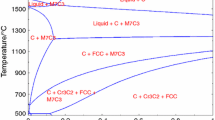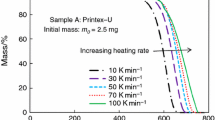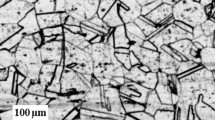Abstract
The isothermal and cyclic-oxidation behavior of three different batches of commercial chromium (purity >99.9%) at 900 and 1000°C has been investigated by means of conventional thermogravimetry and thin-layer activation. Two batches with a similar microstructure and one, with a five times larger average grain size, were used. Isothermal-oxidation experiments were performed in synthetic air for 150 hr. Cyclic-oxidation experiments were executed in static laboratory air with each cycle corresponding to a period of 1 hr at test temperature and 12 min at ambient temperature up to a maximum of 3000 cycles. Results showed significant differences between the oxidation behavior of chromium derived from the three different batches. This was found under isothermal as well as under cyclic-oxidation conditions, especially at 1000°C. The mass-loss rates during cyclic oxidation for the different batches differed up to more than 30 times at 1000°C. In addition, the complementary nature of the different specimen-evaluation techniques, i.e., conventional thermogravimetry and thin-layer activation in cyclic oxidation is shown.
Similar content being viewed by others
References
C. A. Barrett and A. F. Pressler, COREST: A Fortran Computer Program to Analyse Para-linear Oxidation Behaviour and Its Application to Chromic Oxide Forming Alloys, NASA TN D-8132.
C. E. Lowell, J. L. Smialek, and C. A. Barrett, in High Temperature Corrosion, R. A. Rapp, ed. (National Association of Corrosion Engineers, Houston, Texas, 1983), pp. 219–226.
C. E. Lowell, C. A. Barrett, R. W. Palmer, J. V. Auping, and H. B. Probst, Oxid. Met. 36, 81 (1991).
V. A. C. Haanappel and M. F. Stroosnijder, Proc. Cyclic Oxidation Testing as a Tool for High Temperature Materials Characterization, EFC-Event No. 228, 25–26 February, 1999 (Dechema e.V., Frankfurt am Main, Germany) (The Institute of Materials, London, 1999), 225–239.
D. Caplan, A. Harvey, and M. Cohen, Corros. Sci. 3, 161 (1963).
M. F. Stroosnijder, in Application of Particle and Laser Beams in Materials Technology, P. Misaelides, ed. (Kluwer, New York, 1995), p. 399.
T. W. Conlon, Contemp. Phys. 26, 521 (1986).
G. Laguzzi, R. Bisconti, G. Macchi, and M. F. Stroosnijder, Nucl. Instr. Methods Phys. Res. B100, 540 (1995).
M. F. Stroosnijder and G. Macchi, Nucl. Instr. Methods B100, 155 (1995).
C. S. Tedmon, Jr., J. Electrochem. Soc. 113, 766 (1966).
P. Kofstad, High Temperature Corrosion (Elsevier, London, 1988).
Author information
Authors and Affiliations
Rights and permissions
About this article
Cite this article
Murris, I., Jacob, Y.P., Haanappel, V.A.C. et al. High-Temperature Oxidation Behavior of Chromium: Effect of Different Batches. Oxidation of Metals 55, 307–331 (2001). https://doi.org/10.1023/A:1010364311913
Issue Date:
DOI: https://doi.org/10.1023/A:1010364311913




